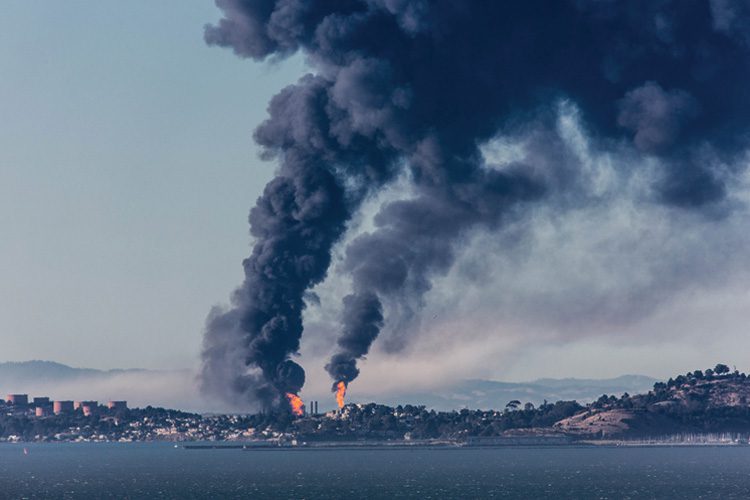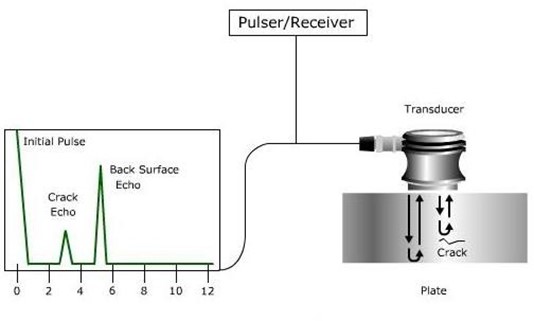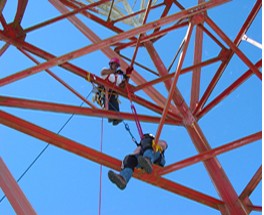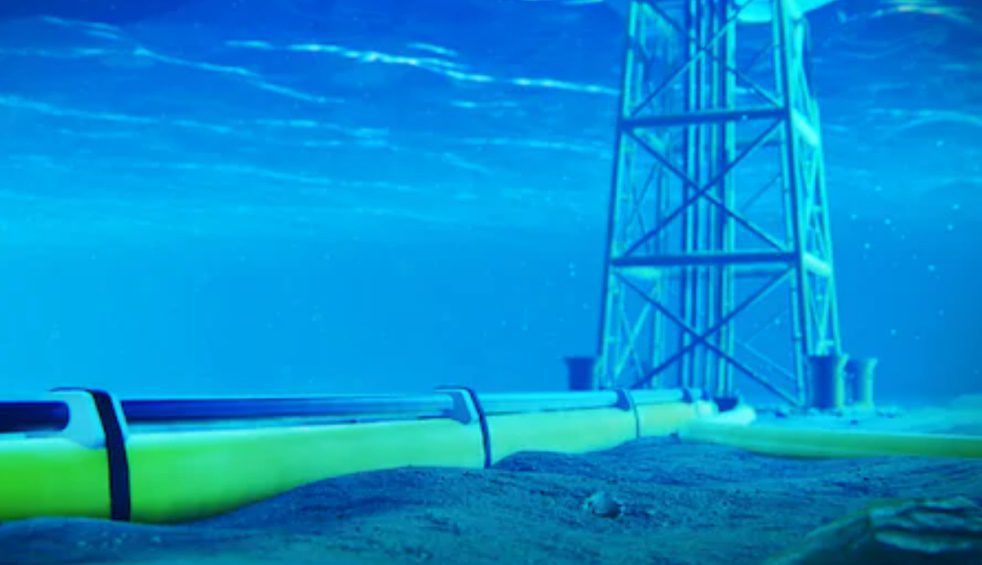Chevron Richmond Refinery Case Study

Chevron Richmond Refinery
Background of case
Chevron Refinery was experienced a catastrophic pipe rupture at their process plant on 6 August 2012. The pipe rupture located in the #4 Crude unit on the piping of 4-sidecut stream 8 inch pipeline. During the incident, there was 10800 barrels per day of light gas oil that flowing through the pipe line. The plant operated at high temperature which is 337.778oC and pressure of 55psig at the incident location. The flammable hydrocarbon was release to the air through the rupture pipe and then vaporized into a huge, massive and opaque vapor cloud.
It was reported that, the vapor cloud take around two minutes to ignite after the release. The number of employees that safely escaped from the cloud before the ignition were eighteen, but one employee which is a firefighter, was caught within the fire as he was inside a fire engine during the ignition. The firefighter could safely out from the fire because he was protected with fire-fighting protective equipment. The incident result six employees to suffer from minor injuries.
The effect of hydrocarbon burning cause huge amount of vapor and black smoke travel to the neighbouring area. It was reported that in the following weeks of the incident, about 15000 of the public community sought for medical treatment due to breathing difficulties, painful throat, chest pain and headaches. In addition to that, there were 20 people were hospitalize due to inpatients for treatment.
Based on the incident report, the technical cause of the pipe rupture was due to the sulfidation corrosion. It was discovered that the pipe had experienced intense thinning, and the average wall thickness close the rupture area was around 40% thinner than the thinnest American coin. The 52-inch piping has initial thickness of 0.322-inch in 1976, but in 2012, it was reported that the pipe had lost 90% of its original thickness due to the corrosion.
Identification of ethical issues
Ethical issue: Management/ organization
The ethical issue in Chevron Refinery incident is mainly related to the management. Management play a vital role in this case study. The first point is that the management did not implement the recommendation provided by the expert to avoid pipe rupture due to the corrosion. It was reported that, before the incident, the small group of employees that expert in sulfidation corrosion provide recommendation regarding the problems, but the recommendations were not employed, and the piping continued in service until it failed.
The next issue is that there was no high-level manager assigned to guarantee that the recommendations were included in the turn-around scope. The 4-sidecut piping was proposed to have 100% component inspection or to upgrade the material of construction. But, the recommendations were excluded by the turn-around planning group. The planning group used Chevron “Framing Document” to outline their scope of work and for endorsement process. Because of no high-level supervision, the lower level employees were accountable to implement the recommendations even though they did not have authority to make decision making.
Then, Chevron refinery also did not have the right person incharge to verify their problem. They did the calculation to determine the date to replaced the thinned pipe but during that process, the right focal person were not there to verify the relevancy of the data that they used for the piping design. Based on their calculation, they predict that the piping can still be operated until the next turn-around. Guideline from API RP 574 already stated the minimum thickness for the piping, but during the detailed calculation, the specification from API RP 574 was not used.
Ethical issue: Safety Culture
The safety issues were also one of the ethical point related to the Chevron incident. Based on the report, the Chevron refinery continued to run regardless of the harmful leaks. There was another leak that occurred at Chevron refinery in 2010, where they continued operation despite the flammable process fluid was released in an active unit. The safety culture developed among the employees cause the incident in 2012 to occur, where they were performing on-stream mitigation even though there was hydrocarbon released.
Secondly, it was found that the employees were disinclined to use the Stop Work Authority. This was proved by the safety culture surveys that show that the employees had become less willing to use their Stop Work Authority between year 2008 and 2010. When it comes to culture, it means that they are practising the same thing for many times. Thus, as the result people will think that they are doing the job or task correctly as they are following the culture. In case of Chevron refinery incident, they were determined to continue the operation because from their experience nothing will happened.
Ethical issue: Engineering Design
The process that involving sulfur compound (can be found in the crude oil feed) should have a special treat as the reaction between sulphur and iron at certain temperature can lead to the corrosion. It also has its own requirement that need to be fulfil by the user to avoid the damage mechanism which can lead the corrosion of the pipe. For Chevron refinery, it was found that the piping material constructed was made up of carbon steel, which can corrode faster when react with sulfur element. Basically, the typical material used to avoid sulfidation corrosion is higher chromium containing steels.
Besides that, carbon steel also has significant variation in rate of corrosion due to the content of silicon. According to American Petroleum Institute (API) RP 939C, carbon steel pipe will corrode at high rate and faster when the silicon content is less than 0.1 weight percent compared to carbon steel piping with high silicon content. American Society for Testing Materials (ASTM) A53B and API 5L had set the specification that the silicon content for carbon steel piping should be at least 0.1 weight percent.
It was found that the 4-sidecut piping in Chevron Refinery did not fulfil the requirement from ASTM A53B of carbon steel to has the minimum content of silicon. This was proved by the post-incident investigation of the carbon steel piping. From that investigation, there were 12 samples taken, and it was found that six of the samples had silicon content less than 0.1 weight percent. The pipe component that ruptured and failed during the incident had silicon content of only 0.01 weight percent.

Figure: The thickness of the rupture pipe.
Analyze the ethical issue
The ethical issues identified are analyze according to the related engineering code of ethic such as National Society of Professional Engineer (NPSE), Registration of engineering Act 1967, American Society of Mechanical Engineers (ASME) and also the related code of ethic.
The Chevron management show the loose management of the plant which did not ensure adherence to safety and all other procedures and regulations. It can be observed that the management did not perform the necessary decision to the suggested recommendations made by the employees. .This is basically the code of ethic violation from the first point in IEEE. In addition to that, the low level employees were given task that they did not suppose to do. In relation to NSPE code of engineering, point 2 of Fundamental of canons, a person can only working in their competence area.
For the employees, it can be observed that the culture develop within their workplace cause they lose their responsibility. The employees reluctance to Stop Work Authority show that the they are keep doing the unsafe work all the times. The Stop Work Authority give obligation to the individual to stop the work when unsafe condition is identified. This situation are part of code of ethic; there should be specific behavior or practices to be followed. According to ASME code of ethic, point 8, the impact on environment and sustainable development need to be consider while performing the duties.
The design of the 4-sidecut pipe was not carried out properly during the design stage. The selection of material for the piping and the minimum requirement for material construction were not properly followed by the Chevron refinery. Ethic in engineering design required the design that are safe for the future application. NPSE code of ethic, under Rule of Practice 1 (b), mentioned that the approval of any engineering documents can only be done if it is compliance with the relevant standard. In case of Chevron, it can be observed that the data used to calculate the thickness of the pipe was not reliable and following the standard.
Thus, it is clear that the main ethical issue that led to the incident were due to management, safety or social and the design (technical) error. The management error is the one that domain in Chevron refinery incident. The errors were accumulated due to lack of responsibility from both top and bottom line, unclear line of authority and poor management.
Suggestion to solve the problem
The empowerment of the management line are one of the solutions for this ethical issue. The high level management need to understand their role and responsibility and become the role model to the employees. The management need to show the ethical behavior and decision in their act. They need to provide guideline and remind the employees on the rule and regulation. Besides that, the management have to alert with any respond by the employees. The effective leadership from the management are important to ensure the plant are working in safety mode.
The best suggestion for the problem related to the safety culture is that enforcement of the process safety awareness. All the employees need to be educated with safety awareness or information related to their process plant. Safety awareness among the employees can be done through the lesson learn from previous incident that already occurred. The employees should alert with the safety of their plant and know what they should do when problem occur. It is important for the employees to identify and understand the hazard to develop the effective safety culture.
The employee also need to be educated with safe work practice. The technical guideline for safety operating procedure need to be outline for every task to ensure that safety were take into the consideration. For example, in case of dealing with hazardous or flammable task, the person in charge should obtained the work permit before they can start their work. All level of management must support and strengthen the process safety system.
The applicable law and regulation need to be specify before the process design started and all the related focal person should understand the stated specifications. All the guideline must be followed to ensure that safety of employees and plant process. To strengthen the process, person in charge from regulatory need to sit together during that process stage.
Conclusion
As a conclusion, an incident would not occur when all level of people in workplace are take part effectively to fulfill their responsibility. Study case from Chevron refinery show that, a little ignorance or lack of responsibility to the problem can lead to major disaster. Management and employees need to work together hand in hand to ensure the plant operate safely. The culture within the organization should be develop with rules, regulations and also ethics.
References
U.S. Chemical Safety and Hazard Investigation Board (2015). Final Investigation Report Chevron Richmond Refinery; Pipe Rupture and Fire.
API RP 939-C: Guidelines for Avoiding Sulfidation (Sulfidic) Corrosion Failures in Oil Refineries. 1st ed.,
Section 6.2.3.2, May 2009.
ASTM Standard A53/A53M-12: Standard Specification for Pipe, Steel, Black and Hot-Dipped, Zinc-Coated,
Welded and Seamless. 2012.
To be added in appendices
1. code of ethic from IEEE;
“to accept responsibility in making decisions consistent with the safety, health, and welfare of the public, and to disclose promptly factors that might endanger the public or the environment”
2. Code of ethic from NPSE, point 2 in Fundamental canons
“Perform services only in areas of their competence”
“ Engineers shall consider environmental impact and sustainable development in the performance of their professional duties”
“Engineers shall approve only those engineering documents that are in conformity with applicable standards”





Responses